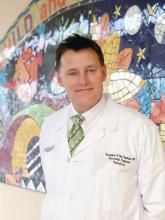AT PAS 17
SAN FRANCISCO – One in eight teenagers experienced at least one major depressive episode in 2015, according to the National Institute for Mental Health. Yet the recent uptick in teen suicide rates suggests that U.S. mental health care services are not meeting their needs.
A team at the University of Illinois in Chicago, led by Benjamin Van Voorhees, MD, MPH, hopes so, and they have spent the past several years developing and testing such a program with a National Institute of Mental Health (NIMH) grant.
“Adolescents are in a really plastic moment in their psychobehavioral repertoire and brain development as they program themselves to adapt to adult life,” Dr. Van Voorhees said in an interview. “Right now we have nothing to offer those individuals other than an occasional referral to an overtaxed mental health system. The only rational strategy is a mass dissemination model, which is going to have to be technology.”
Dr. Van Voorhees has developed an online, self-guided depression prevention program called Competent Adulthood Transition with Cognitive Behavioral Humanistic and Interpersonal Training (CATCH-IT). At the Pediatric Academic Societies meeting, Dr. Van Voorhees and his University of Illinois colleagues presented findings from several research steps in their study to evaluate the effectiveness of CATCH-IT in preventing teen depression requiring clinical attention.The CATCH-IT program is aimed at teens showing early signs of depression or predepressive symptoms as determined through screening during well checks or other visits for acute or chronic concerns. The study uses multiple screening tools in selecting participants, but Dr. Van Voorhees estimates that screening in practice would require about 1-2 minutes of a medical assistant’s or nurse’s time, followed by 1-2 minutes of the practitioner’s time for positive screens – “and one in five of those screens is going to be positive,” he said.
“The thing we want to convey to primary care practitioners is that these individuals are coming through your office every day, we’re doing nothing for them, and in some ways we are ignoring their enormous future potential adverse trajectory toward mental disorders,” he said.
The program includes 14 modules drawing on cognitive behavioral therapy, behavioral activation, interpersonal psychotherapy, and community resiliency. Six archetypal teens – such as teen living with a single mom or one whose parents are divorcing – are featured in each of the modules to demonstrate six ways of applying the strategies taught in that module. The archetypal teens are around 14-15 years old, but the program is aimed at teens aged 13-18 years, with a reading level at about grade 6, Dr. Van Voorhees said.
In an early pilot, Dr. Van Voorhees’s research team tested outcomes from the program and how doctors offered it to patients. That cohort comprised 83 adolescents aged 14-21 years who had depressive symptoms without meeting criteria for any mental disorders. All were offered the opportunity to participate in the CATCH-IT program, but 40 received only a brief recommendation from their providers. Providers of the other 43 spent 5-15 minutes doing motivational interviewing with the teens, who subsequently received three motivational follow-up calls from social workers.Two and a half years after those teens used the CATCH-IT intervention, they showed “a sustained reduction in automatic negative thoughts and educational impairment,” but no difference in their perceptions of support from family or friends. The lack of a control group in that pilot limits what conclusions can be drawn about the program’s effectiveness, but the researchers did learn that motivational interviewing led to greater engagement with the program, compared with teens who received a brief recommendation of it.
Therefore, in the subsequent – and still ongoing – study, physicians used motivational interviewing when offering teens the opportunity to join the program. That study does include a control group, in which participants are assigned a generic health education program online instead of CATCH-IT, and the randomized participants have been stratified by site, gender, and depression risk level.
The researchers first assessed the baseline characteristics of the population, recruited from 38 clinics in two cities. The study enrolled 369 teens aged 13-18 years – 248 in Chicago and 121 in Boston. All were identified as high risk for depression based on elevated scores on the Center for Epidemiological Studies Depression (CES-D) scale or the Kiddie Schedule for Affective Disorders Scale (K-SADS). Two thirds (68%) of participants are female, and most (63%) are in high school. About a third (34%) are in middle school. The racial/ethnic breakdown of the sample is 21% Hispanic, 26% black, 43% white, 4% Asian, 6% multiracial, and 1% other (which adds up to 101% due to rounding). More than half of the participants’ mothers (60%) and fathers (53%) were college graduates.
The teens completed the CES-D, the Screen for Child Related Anxiety Disorders (SCARED), the Beck Hopelessness Scale (BHS), the CRAFFT screening for adolescent substance misuse and the Disruptive Behaviors Disorder Scale (DBD-A). A parent of each teen also filled out the CES-D and DBD-A.
The baseline results did not suggest any concerns about substance use, hopelessness, or disruptive behaviors such as ADHD or conduct disorder. But the average scores on the CES-D and SCARED sat just at the threshold for a potential depressive or anxiety disorders. A CES-D score of at least 16 suggests a possible depressive disorder, and a SCARED score of at least 25 suggests a possible anxiety disorder. The mean scores on the teens’ CES-D were 17.7 in the Chicago cohort, 15.4 in the Boston cohort and 16.9 for the whole group. Similarly, the SCARED mean scores were 26.3 in the Chicago cohort, 23.5 in the Boston cohort and 25.3 overall.
Scores from K-SADS showed subthreshold levels of depressed mood in 36% of teens in both cities, and a nearly identical subthreshold level of irritability. Subthreshold anhedonia was identified in 20% of the overall population. One percent of the overall population had current suicidal ideation.
The next steps are to analyze outcomes among the participants, as the team is doing currently. They have just passed the 1-year anniversary of the trial and are analyzing the data they collected over the past year. The study will run an additional year for longer-term data collection.
One of the abstracts presented at PAS explored the economic implications of incorporating CATCH-IT in primary care.
“The cost for implementation is where the challenge is,” Dr. Van Voorhees said. “Screening takes time, and calling people takes time.” But when spread across a practice’s overall clientele in a year, the costs drop considerably, he said, and savings from effective identification and depression prevention may outweigh costs. The researchers have not yet conducted a cost-effectiveness study because they still are analyzing data on outcomes.
But Dr. Van Voorhees is optimistic about the possibilities of the program.
“What this entire model is about is, how do we understand what’s going on in the environment of the primary care clinic to find these people, identify them, and motivate them, and how can we give them something relevant enough to actually complete,” Dr. Van Voorhees said in the interview. “Then, let’s actually see if it changes their behavioral trajectory.”
The National Institute of Mental Health funded the research. Dr. Van Voorhees has consulted for Prevail Health Solutions, Mevident, Social Kinetics, and Hong Kong University on development of Internet-based interventions.



